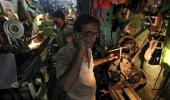The government has an opportunity right now to save Indians from deep recession, and in many cases, starvation, notes Kalyan Singhal.

Thanks to the imaginative leadership of the Indian government, India is the first country in the world to implement a total lockdown to protect its citizens from the lethal coronavirus.
However, the Indian government's current economic package of Rs 1.7 lakh crore (or about one percent of the GDP) is totally inadequate.
A large part of India's population needs more support if it is to endure.
Any difficulties they face in these desperate times will undo the benefits of social distancing and put India back many years, and that will cost far more in the long run.
The recently passed US economic package to remediate virus-related harm is about ten percent of its GDP.
The US is now planning to devote a further 10 percent of its GDP to a second economic package.
Given its poverty, India would need a larger share of its GDP than the US to alleviate the effects of this crisis.
The lockdown could bring great hardship to low-income citizens who constitute about 70 percent of India's population.
Unlike the remaining 30 percent, these people are not part of the organised economy and, because they have no savings, the day they don't work is a day that they and their families don't eat.
According to the United Nations's International Labour Organisation, 'about 400 million people working in the informal economy in India are at risk of falling deeper into poverty due to the coronavirus crisis which is having catastrophic consequences.'
Unlike the US, India does not have such social safety programs as food stamps and unemployment insurance.
Furthermore, tens of millions of low-income migrant workers have now left their urban places of employment to return to their rural villages.
The 70 percent have no medical insurance and no money to pay for healthcare.
Some may have inadvertently carried the virus with them to their villages, which have very little in the way of healthcare facilities.
India does not have anything that resembles US Medicaid which allows the poor without insurance to get emergency medical help.
While those in the top 30 percent income group will on the balance benefit from the lockdown driven lower probability of getting the infection, it is doubtful whether the 70 percent will be better off.
They will be certainly further pushed down the poverty scale, suffer malnutrition, and in many cases, face death by infection or starvation.
The fate of the 70 percent therefore depends on what the Indian government does next to ensure them food and healthcare.
Because over 70 percent of India's population has little money to spend, not only could many people starve, but the prices of some necessary goods could crash as well.
The government has an opportunity right now to save Indians from deep recession, and in many cases, starvation.
A revised plan should increase spending across the board, particularly on income support and the supply of food grains.
I offer five recommendations for how India's government should proceed:
- 1. The first priority is to control the virus.
The second is to ensure that no one starves.
The third is to save the economy from a deep recession. - 2. Give every adult and child below sixty years of age a monthly grant of 2,000 rupees and everyone over sixty a monthly grant of 4,000 rupees until the crisis is over.
These grants would cost three trillion rupees (three lakh crore rupees) per month (about 1.5 percent of the GDP). - 3. The government should purchase all available food grains from the current harvest.
It should distribute the food grains from these purchases and from its huge buffer stocks to the entire population for free. - 4. The government should mobilise rural healthcare and expand telemedicine to remote areas.
India's medical infrastructure is not equipped to deal with the magnitude of the rapidly developing crisis.
In regions that do not have adequate facilities, the government should build makeshift hospitals as soon as possible.
DRDO (the Defense Research and Development Organisation) and other similar organisations can design partially prefabricated hospitals so that private and public sector companies can start to manufacture parts.
This process will take time but may still help if the crisis drags on and will leave the country better prepared for future health crises. - 5. The government should finance the above proposals through a combination of printing money and budget deficit.
In the current context when money supply is plummeting, printing money does not risk driving inflation.
Indeed, this approach would ameliorate the severity of the recession to follow and protect against price crashes in industries that provide goods and services to the 70 percent.
Copyright, Kalyan Singhal.
Kalyan Singhal is the McCurdy Professor of Business at the University of Baltimore.
Since 1992, he has edited Production and Operations Management, one of the top 20 business journals on the BusinessWeek list.
Ksinghal@ubalt.edu
Any publication in any country is free to publish this article after informing the author via email.










